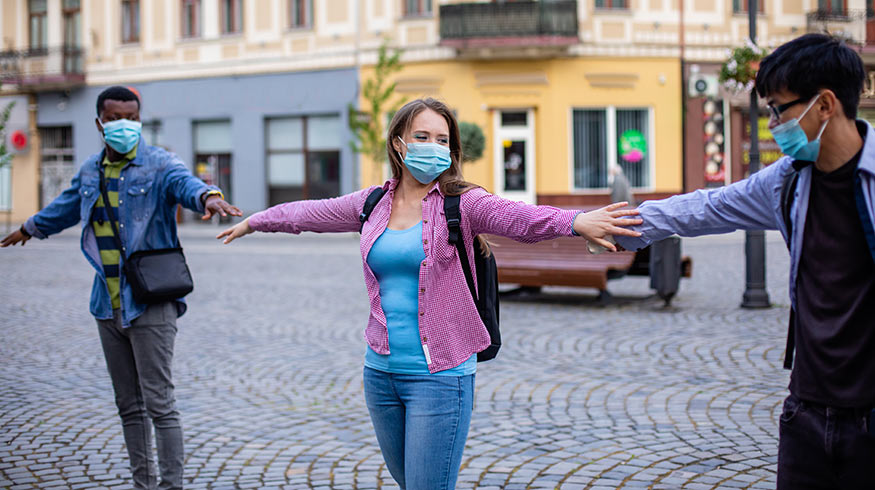However, while public health mandates have been a part of American culture since the country’s founding moment, resistance to immunization treatments has an even longer history, dating back to Westerners’ suspicious assessment of Chinese inoculation practices that had been used to protect children against smallpox since the eleventh century.4 Suspicion, hesitancy, and organized resistance have accompanied vaccination regimes implemented to fight smallpox, measles, and polio as well as other common diseases over the past two centuries on the basis of religious and ethical beliefs, cultural biases, anger about government overreach, and skepticism of science despite overwhelming evidence that vaccinations saved lives and reduced suffering. So, perhaps, it is not surprising that resistance to vaccinations, mask-wearing mandates, and other public safety measures have played a significant role in the trajectory of the COVID-19 pandemic in the U.S. and elsewhere.
On Friday, October 1, 2021, the U.S. death toll from COVID-19 crossed the 700,000 mark, surpassing the 675,000 deaths from the influenza pandemic of 1918 and 1919 over a century before5 and totaling more than all the deaths in America’s wars in the twentieth and twenty-first centuries combined.6 This grim milestone occurred in spite of freely available, highly effective vaccines and scientific consensus around the effectiveness of social distancing and mask-wearing in public spaces to reduce the spread of the highly contagious pathogen. It also serves as a reminder that epidemics are as much social phenomena as they are biological ones.
The COVID pandemic is not merely a crisis of public health, it is a crisis of faith in American institutions and in our civil society. Political polarization has confounded efforts to build consensus about how to combat the disease and increased distrust and resentment. The perspectives and resources collected here provide a humanistic context to help understand the complexities of the current crisis. They also suggest ways the humanities can ameliorate suffering and mitigate future crises by forging connections that simultaneously recognize and transcend our individual needs and identities by encouraging us to embrace our role as citizens and community members.
Notes
- Lawler, Andrew. “How a Public Health Crisis Nearly Derailed the American Revolution.” National Geographic, April 16, 2020.
- “Individual Rights and the Public’s Health: Constitutional, Ethical, and Political Aspects of COVID-19 Measures and Their Enforcement.” The Network for Public Health Law, February 24, 2021.
- Mosvick, Nicholas. “On this Day, the Supreme Court Rules on Vaccines and Public Health.” The National Constitution Center, February 20, 2021.
- Harris, Jim. “Rash Decisions: Anti-vaccination Movements in Historical Perspective.” Origins: Current Events in Historical Perspective, November 2019.
- Bosman, Julie, and Lauren Leatherby. “U.S. Coronavirus Death Toll Surpasses 700,000 Despite Wide Availability of Vaccines.” The New York Times, October 1, 2021.
- Sachs, Jeffrey. “The Real Reason this Pandemic is the Deadliest to Ever Hit the US.” CNN.com, September 22, 2021.
Find out how you can get informed, get involved, and take action on this and other issues.
Voices
What some experts are saying:
- Mooney, Graham. “How to Talk About Freedom During a Pandemic.” The Atlantic, May 19, 2020.
- Nay, Olivier. “Can a Virus Undermine Human Rights?” The Lancet, April 20, 2020.
- Cohen, Jonathan. “Individual Freedom or Public Health? A False Choice in the Covid Era.” Hastings Bioethics Forum, June 9, 2020.
- Burris, Scott. “Individual Liberty, Public Health, and the Battle for the Nation’s Soul.” The Regulatory Review, June 7, 2021.
- Warren, Tish Harrison. “The Limits of ‘My Body, My Choice’.” The New York Times, September 26, 2021.
- Laycock, Douglas. “What’s the Law on Vaccine Exemptions? A Religious Liberty Expert Explains.” The Conversation, September 15, 2021.
- Ostherr, Kirsten. “Humanities as Essential Services.” Inside Higher Ed, May 21, 2020.
Resources
Materials for further exploration:
- Bayer, Ronald. “The Continuing Tensions between Individual Rights and Public Health. Talking Point on Public Health versus Civil Liberties.” EMBO Reports, December 2007.
- Ethics Guidance and Resources on Covid-19, The Hastings Center.
- Resources Archive, The Network for Public Health Law.
- Public Health Law Academy, Change Lab Solutions.
- Altschuler, Sari, and Elizabeth Maddock Dillon. “Humanities in the Time of Covid: The Humanities Coronavirus Syllabus.” ISLE: Interdisciplinary Studies in Literature and Environment, Autumn 2020.
- Pandemics: Past, Present, and Future, Origins: Current Events in Historical Perspective.
- History of Vaccines, The College of Physicians of Philadelphia.

